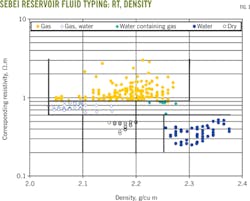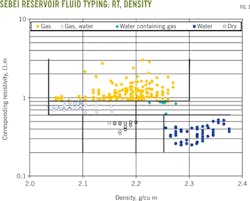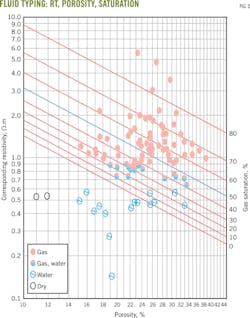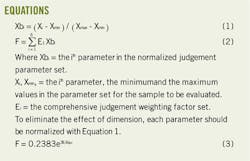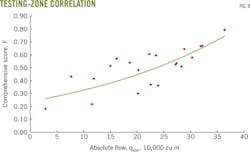View Image Gallery>>
Ou Chenghua
Southwest Petroleum University
Sichuan, China
Comprehensive evaluation and classified recognition (CECR) of fluid typing and zonation (FTZ) is a prerequisite for developing multilayer sandstone gas reservoirs (MLSGR).
The geological features of these formations complicate this evaluation. They consist of fine sandstone and siltstone with high heterogeneity; sand and shale are mixed in interbed layers; there are multiple gas sources (methane, thermogenic, and inorganic genetic); and fluid distribution is diverse and difficult to recognize.
This article presents a methodology to evaluate MLSGRs better. It uses static and dynamic data from Sebei gas reservoir in northwest China to analyze and summarize seven typical recognition modes of gas zones, water zones, gas-and-water zones, water-containing-gas zones, and dry zones. It ultimately establishes geological modes for CECR of FTZ.
Sebei gas reservoir
With this methodology, more than 27,000 well layers have been successfully evaluated in the Sebei reservoir.
Sebei is one of the major gas producers in northwest China. It is in the quaternary depression in Sanhu area of Qaidam basin on the Qinghai-Tibet plateau.
It is a typical MLSGR with multilayers, multigas, and water systems, shallow lacustrine deposition with a transversely stable reservoir, longitudinally interbed sand and shale layers, strong heterogeneity, high porosity (POR), low permeability, and very small pore throats.1 2 3 4
Discovered in the 1970s, Sebei began full production at the beginning of this century and is entering the late stage of stable production and the onset of production decline.
Conducting systematic CECR of FTZ is necessary for profitable development and for the drop in production to be slowed.
Generally, CECR of FTZ in Sebei gas reservoir has been determined with corresponding resistivity (RT), POR, and gas saturation (SG) cross plots. These, however, do not subdivide gas zones or distinguish gas-and-water zones from water-containing-gas zones.5 6 A better method is needed.
A new methodology
The methodology proposed in this article uses the point-by-point and separate-layer parameters calculated with logging interpretation of rock-cores. Fluid zonation and well production-capacity data are based on field tests.
Using these Sebei data allows development of a density (DEN)-RT cross plot with a right-angle-coordinate system (Fig. 1). An RT-POR-SG cross plot with a double-logarithmic coordinate system was created by relating the depths of fluid zones to the RT, POR, SG, and DEN (Fig. 2).6 7
By integrating these two cross plots, we determined five fluid-typing parameter bounds for Sebei (Table 1). It was clear that the longitudinal distribution of gas and water was complex and more FLZ information was required.
View Image Gallery>>
Referring to previous research and using available field data, we ranked parameters in descending order of contribution to production.8 9 10 These were gas saturation, porosity, effective thickness, permeability, clay content, and irreducible-water saturation.
We then used the analytical hierarchy process to weight these parameters.11 12 13 They were 0.4, 0.35, 0.25 0.15, -0.1 and -0.05, respectively.
With weighted parameters to judge Sebei gas zones, a comprehensive scoring model was developed (Equations 1 and 2 in the accompanying box).
We conducted correlation analysis between the absolute open flow (qAOF) and the comprehensive score (F) for 23 single-well, single-zone tests and created the correlation expression. We then changed the qAOF classification for the three types of gas zones to comprehensive-score classifications (Equation 3, Fig. 3).
Seven parameters
The evaluation scores gave us a total of seven fluid-zonation criteria for Sebei MLSGR. These include the RT, POR, SG, and DEN, as well as the fluid category (one of five) and gas type (Type I, II, or III), which are established after the evaluation scores of each gas zone are calculated.
These criteria and logging data allowed us to determine typical characteristics and recognition modes of seven FTZs (Fig. 4).
Results show that all seven types of gas zones exist in Sebei, where gas zones and water zones make up more than 80% of the reservoir, indicating complex gas-water distribution (Table 3, Figs. 5 and 6)
Gas zones account for about half of the reservoir thickness, while the other half is made up of water zones with scattered water-containing gas and dry zones.
Type I gas makes up 66.9% of the accumulated gas zone thickness. Type II accounts for 31.6% and Type III is only 1.7%.
Methodology applications
Combing FTZ logging recognition with multifactor evaluation of gas zone quality is what sets this methodology apart from others.
Drawing upon multiple sources of basic data and solid logging interpretation results is critical if this CECR of FTZ method is to be successful. For Sebei, we used cores, logging data, field-gas tests, and single-well-deliverability test.
Good interpretation of these data is necessary as well. This includes calculating point-to-point parameters (POR, RT, clay content, SG, and irreducible water saturation), interpreting each layer (gas zone, water zone, gas-and-water zone, and dry zone), and determining effective thickness, average POR, average RT, average clay content, average SG, and average irreducible water saturation for each well.
The methodology developed here should be used to solve general problems, not specialized problems such as thin-bed identification, low-resistivity gas-zone recognition, or high-resistivity water-zone recognition.
Other factors can affect the efficacy of this method, including political and economic rules and regulations, and the level of natural gas production technology in different countries, as well as international gas-price fluctuation.
FTZ parameters must be readjusted to fit specific MLSGRs.
View Image Gallery>>
Acknowledgments
The author would like to thank Jia Yinglan, Wang Xiaolu, Liu Junfeng, He Yan from China National Petroleum Corp. for their assistance on this article. Mr. Chenghua would also like to recognize the financial support of the National Major Basic Research Development Program of China (2014CB239205), which made this article possible.
References
1. Zhu, G.Y., Wang, Z J, Dai, J.X., and Su, J., "Natural gas constituent and carbon isotopic composition in petroliferous basins, China," Journal of Asian Earth Sciences, Vol. 80 No. 5, pp.1-17, 2014.
2. Liu, H., Pang, J., Wang, X.L., Yu, X.N., and Li, Q., "Analysis of interlayer interference and research of development strategy of multilayer commingled production gas reservoir," Energy Procedia, Vol. 16 (Part B), 2012, pp. 1341-1347.
3. Hu, G.Y., Luo, X., Li, Z.S., Zhang, Y., Yang, C., Li, J. Ni, Y.Y., Tao, X. W., "Geochemical characteristics and origin of light hydrocarbons in biogenic gas," Science China: Earth Sciences, Vol. 53 No. 6, 2010, pp. 832-843.
4. Hua, R.X., Jia, Y. L., Li, Q., Xu, W.P., Qin, C.H., "An analysis of gas-water distribution and its movement law in the Sebei gas field," Natural Gas Infustry, Vol. 29 No., 7, 2009, pp.68-71.
5. Chen, X., and Gao, C.Q., "Application of dual saturation method in the low saturation unconsolidated gas-bearing sandstone in Sanhu area," Geophysical Prospecting for Petroleum, Vol. 50 No. 1, 2011, pp. 94-98.
6. Hu, Y. J., He, Y., Liao, M. J., Wan, Z. J., and Guo, K.M., "The logging interpretation method for the loose sandstone reservoirs of No.1 gas field in Sebei," World Well Logging Technology, Vol. 193 No. 1, 2013, pp. 29-33.
7. Worthington, P.F., "Quality-assured evaluation of fresh water-bearing hydrocarbon reservoirs," Journal of Petroleum Science and Engineering, Vol. 78 No. 2, 2011, pp. 542-55.
8. Zhao, Y., Wu, S.H., Yue, D.L., Xue, Y.X., and Wen, L.F., "Study of flow units in No.1 Sebei gasfield of Qinghai province," Geoscience, Vol. 23 No. 2, 2009, pp. 341-346.
9. Tobin, R.C., McClain, T., Lieber, R.B., Ozkan, A., Banfield, L. Marchand, A.M.E., and McRae, L. E., "Reservoir quality modeling of tight-gas sands in Wamsutter field: Integration of diagenesis, petroleum systems, and production data," AAPG Bulletin, Vol. 94 No. 8, 2010, pp. 1229-1266.
10. Xie, L., Yang, T.Y., Zhang, S. Q., "Log analysis of the effective reservoirs and caprocks in Sebei gas field," Natural Gas Industry, Vol. 20 No. 5, 2003, pp. 30-33.
11. Liao, C. N., "Fuzzy analytical hierarchy process and multi-segment goal programming applied to new product segmented under price strategy," Computers & Industrial Engineering, Vol. 61 No. 3, 2011, pp. 831-841.
12. Vaidya, O.S., and Kumar, S., "Analytic hierarchy process: An overview of applications," European Journal of Operational Research, Vol. 169 No. 1, 2006, pp. 1-29.
13. Shi, Q. Li, G.P., "Log interpretation of uncosolidated gas-bearing sandstone in Qaidam basin, China," Well Logging Technology, Vol. 24. No. 1, 2000, pp. 42-46.
The author
Ou Chenghua ([email protected]) is an associate professor, reservoir description, Southwest Petroleum University, Chengdu City, China. His focus areas include tight-reservoir description theory and technology, complex reservoir description, and residual-oil distribution. He holds a BS in oil and gas geology, an MA in coal, oil, and gas exploration, and a PhD in petroleum engineering, all from Southwest Petroleum University.
